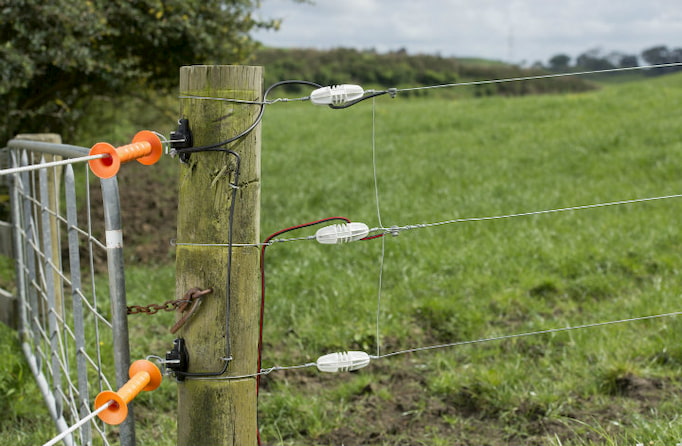How to Set Up an Electric Fence to Keep Your Dog Safe
The safety of our pets is important to us but at the same time we don't want to prevent our canine friends from having fun. Electric dog fences are the ideal solution when it comes to providing both freedom and safety. They are more favourable to zoning laws, easy to maintain and you don't have to worry about leaving the gate open. An electric fence is also more affordable than a traditional fence and it is way easier to install them.
The static shock your dog gets will get its attention instead of hurting it and when you train it, your K-9 won't experience the shock as much as it will respond to the audio that comes beforehand. Whilst no one can see where those boundaries are (except for the person that set the wires up) your dog knows that they are there and it can't jump over or dig underneath them.
Aggressive and stubborn dogs may accept the shock just so they can leave the yard. For these types of dogs you can get collars with stronger corrections or collars that warn the dog by spraying a citronella spray or emitting the shock in front of their face.
Round the corners of the fence but avoid any sharp 90° angles or again the signal is going to be cancelled out. Make a simple sketch of your yard including buildings, the driveway, sidewalks, the underground utilities, gardens etc. Remember the transmitter needs to be in a dry and protected area like a garage or a shed but don't place it near a breaker box and make sure it is away from appliances. Once you've selected your layout it's time to set up the wire.
If you are going to bury the wire you'll usually need to make an incision between 2.5cm and 7.5 cm deep so you don't trip on them or cut them when using the lawnmower. But what if you need to run it through the driveway or any concrete surface? In this case you should try to run the electric fence wire through an existing gap, joint or crack but make sure to clean them before placing the wire.
Once you lay the wire in the gap put a little bit of patching or caulking compound or silicone to secure the wire. If there aren't any gaps or joints make an incision with a saw. In case you are going to place them across a gravel or dirt driveway use PVC pipes to keep them protected. Avoid running the wire along other electrical wires, telephone, television and antenna wires or near a satellite dish. If you don't know the exact location of your utility lines get in contact with the local utility company.
How They Work
Electronic pet containment systems work by sending a small electric charge through wires. Electric fences use a transmitter which plugs into a standard power outlet, to send the charge. The charge creates a boundary that sounds a warning to a collar on your dog whenever it comes near it. The boundary is made with the wires and the mild static correction is harmless but enough to make the dog accustomed to its boundaries.The static shock your dog gets will get its attention instead of hurting it and when you train it, your K-9 won't experience the shock as much as it will respond to the audio that comes beforehand. Whilst no one can see where those boundaries are (except for the person that set the wires up) your dog knows that they are there and it can't jump over or dig underneath them.
Precautions
You shouldn't install such a system if you have a guard dog, dogs that are vicious or ones that have health problems. Always consult your veterinarian first about he suitability of the system you want to purchase. Be aware that these systems are not going to work with every dog as some may refuse to respond to the signals coming from the transmitter.Aggressive and stubborn dogs may accept the shock just so they can leave the yard. For these types of dogs you can get collars with stronger corrections or collars that warn the dog by spraying a citronella spray or emitting the shock in front of their face.
Prepping
The first thing you'll need to determine is the area you'll want to cover and this will depend on the transmitter. The majority of transmitters can power electric fences surrounding an area of about 25 acres and they also come with around 90 metres of wire. For bigger areas you'll need a high-powered transmitter. You'll also need to mark underground utility lines so the dog's collar doesn't activate where it shouldn't. Electric fences positioned in parallel should be at least 1.2 metres away from each other. If they are too close they will start cancelling each other out. If your neighbour has an electric fence too, you should keep your wires separated from his by about 1.8 to 3 metres.Round the corners of the fence but avoid any sharp 90° angles or again the signal is going to be cancelled out. Make a simple sketch of your yard including buildings, the driveway, sidewalks, the underground utilities, gardens etc. Remember the transmitter needs to be in a dry and protected area like a garage or a shed but don't place it near a breaker box and make sure it is away from appliances. Once you've selected your layout it's time to set up the wire.
Installation
The wire can be either buried in the ground or attached to your existing fence using cable ties. The wires should be mounted at your dog's shoulder height in order for the collar to pick up the best signal possible. If you happen to have multiple dogs running around you'll need to place the wire at the shoulder height of the middle size dog. Remember the fence boundary should make a continuous loop back to the transmitter. You can also use twisted wire to connect both ends of the boundary wire to your transmitter.If you are going to bury the wire you'll usually need to make an incision between 2.5cm and 7.5 cm deep so you don't trip on them or cut them when using the lawnmower. But what if you need to run it through the driveway or any concrete surface? In this case you should try to run the electric fence wire through an existing gap, joint or crack but make sure to clean them before placing the wire.
Once you lay the wire in the gap put a little bit of patching or caulking compound or silicone to secure the wire. If there aren't any gaps or joints make an incision with a saw. In case you are going to place them across a gravel or dirt driveway use PVC pipes to keep them protected. Avoid running the wire along other electrical wires, telephone, television and antenna wires or near a satellite dish. If you don't know the exact location of your utility lines get in contact with the local utility company.




Comments
Post a Comment